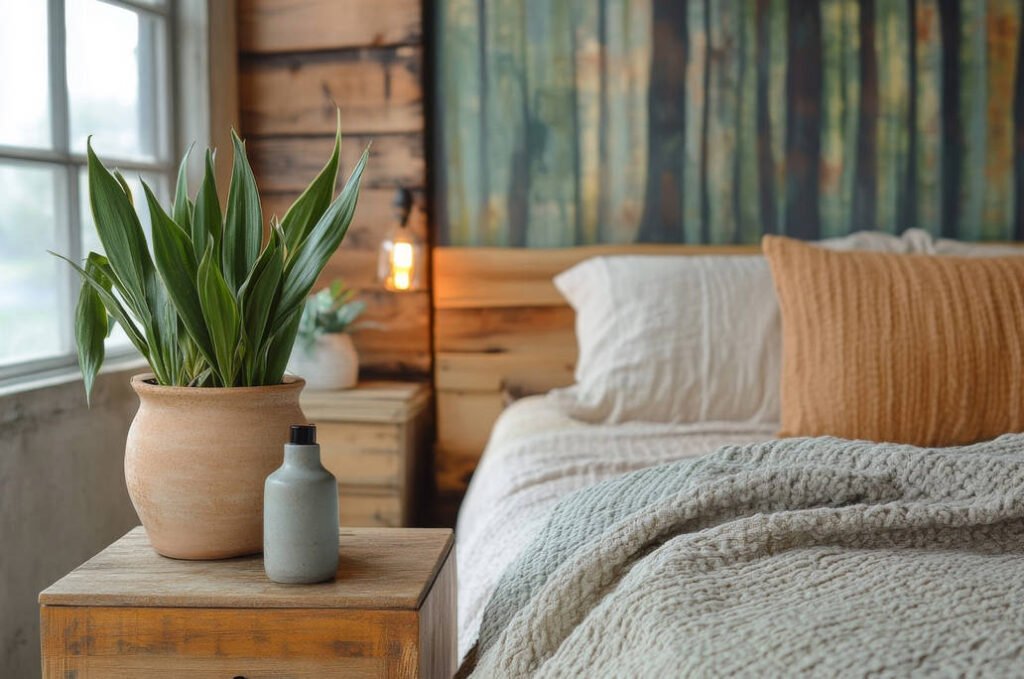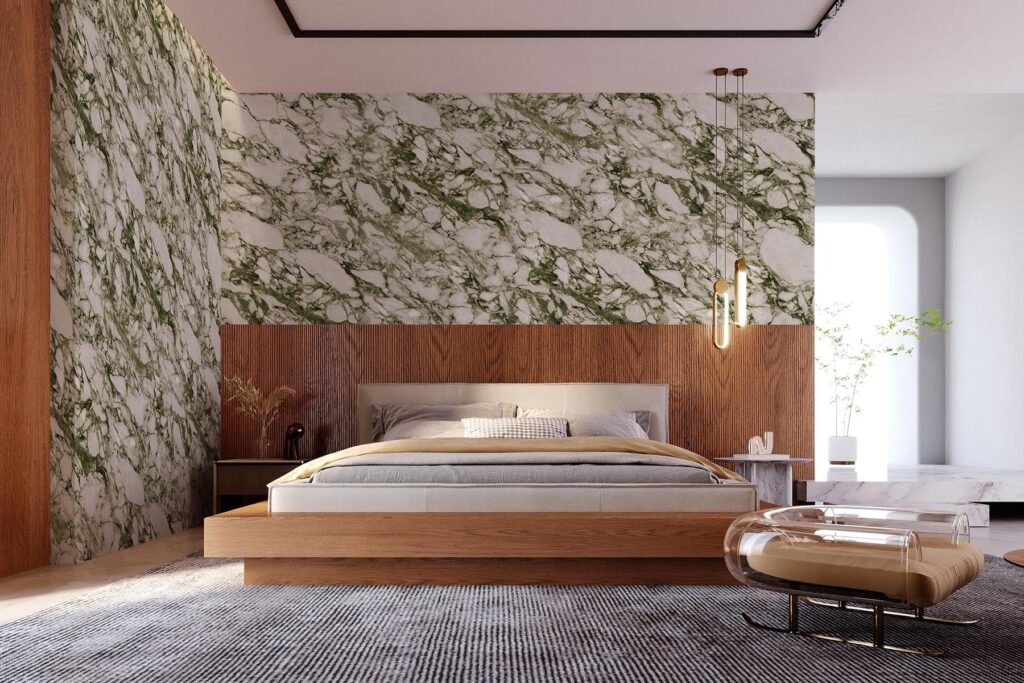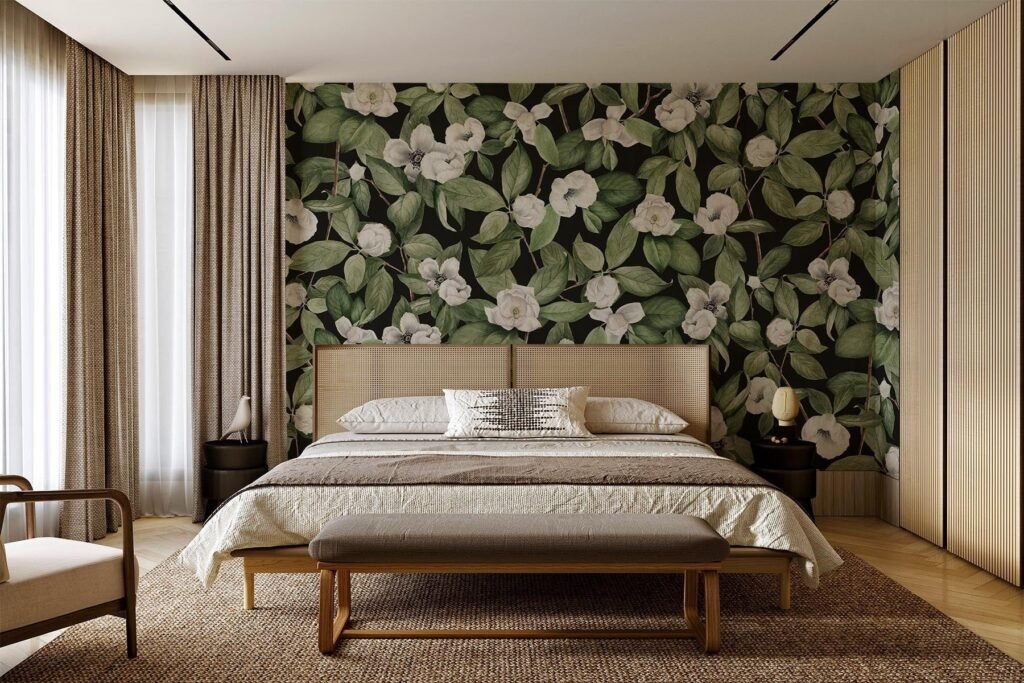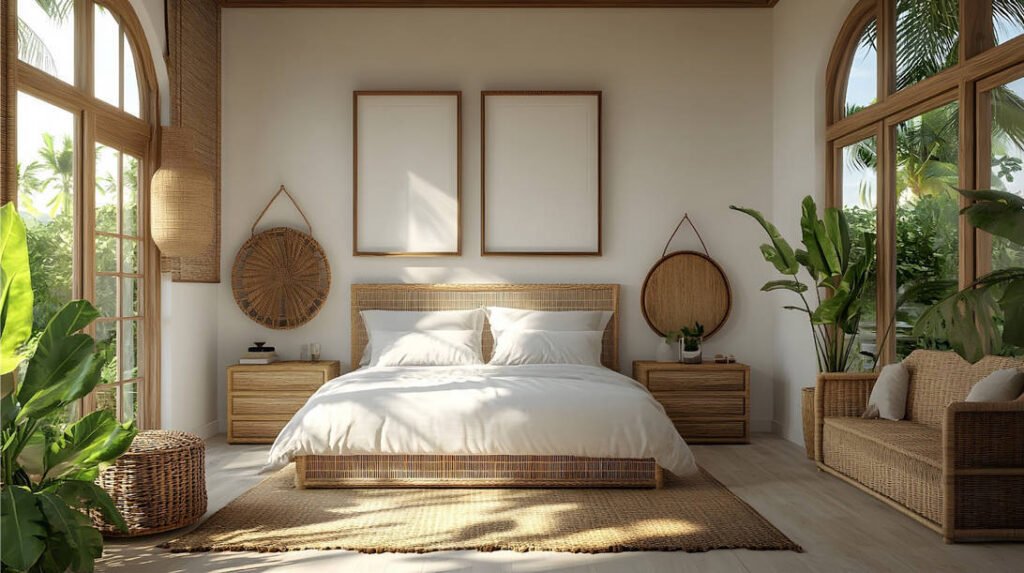
When I think of a restful bedroom, it’s never about perfection—it’s about peace. The kind that comes from soft light, earthy textures, and the quiet reminder that nature has a place in our most personal spaces. That’s the beauty of biophilic design. It’s not just a trend; it’s an invitation to reconnect with the natural world right from your bedside.
Creating a biophilic bedside area isn’t about adding a forest of plants or covering your walls in greenery. It’s about subtle touches that make you feel grounded—materials that breathe, textures that comfort, and light that follows the rhythm of the day. Over time, I’ve learned that even one natural element can transform how a space feels and how deeply you rest.
Let’s explore seven creative ways to bring that soothing, nature-inspired energy right beside your bed—each one simple, stylish, and refreshingly unique.
1. Wooden Bedside Tables with Organic Texture

There’s something timeless about solid wood furniture, especially when it showcases the raw beauty of its grain. A wooden bedside table doesn’t just hold your lamp or book—it brings warmth and grounding energy to the entire room. I love pieces that still carry visible knots or uneven tones; those imperfections are what make the wood feel alive and real.
Choosing reclaimed or sustainably sourced wood adds an extra layer of meaning. It’s not only eco-friendly but also carries a quiet sense of history. Pairing it with natural accessories—like a linen lampshade, woven basket, or stone dish—creates a balanced look that feels intentional yet effortless.
If you enjoy a touch of creativity, mix wood with other organic materials like rattan or cane for depth. These subtle combinations make your bedside look curated without being fussy. Over time, the wood’s texture deepens and ages beautifully, reminding you daily of nature’s enduring charm.
2. Living Greenery Beside the Bed

Adding greenery next to the bed is one of the most effective ways to bring life—and literal fresh air—into your space. I still remember the first time I placed a peace lily on my nightstand; it instantly made the room feel fresher and calmer. Plants have this quiet magic—they soften edges, fill empty corners, and bring movement into otherwise still spaces.
For low-maintenance options, try snake plants, pothos, or ZZ plants. They thrive even in low light and quietly work to purify the air. You can display them in small ceramic pots, hang trailing plants from a macramé holder, or set up a tiny terrarium for a modern touch.
What I love most about bedside greenery is the feeling it gives when you wake up. There’s something grounding about seeing living leaves before you reach for your phone. It’s a gentle reminder to breathe deeply and begin the day with a sense of calm connection.
3. Natural Light and Sheer Curtains

Few things feel as restorative as morning light filtering softly through sheer curtains. Natural light isn’t just about aesthetics—it directly impacts your mood and sleep rhythm. Positioning your bed to catch the morning sun, even slightly, can shift your mornings from groggy to gently energized.
Sheer linen or cotton curtains are perfect for diffusing sunlight. They let brightness in without harsh glare and move beautifully with the breeze. If privacy is a concern, you can layer them with bamboo blinds or heavier drapes that you open during the day.
At night, recreate the natural rhythm with warm, dim lighting. A soft amber bedside lamp or sunrise alarm clock helps your body wind down naturally. Over time, these small lighting choices align your space with nature’s cycle, helping you feel more rested and balanced.
4. Stone and Ceramic Accents

Adding stone or ceramic elements around your bedside brings texture and a sense of timeless calm. I’ve always loved the contrast between cool, solid stone and the softness of fabric or wood—it feels both grounding and elegant. Think marble trays, handmade ceramic lamps, or clay vases with dried stems.
Natural stone adds subtle luxury without feeling overly polished. Even a simple piece—a soapstone coaster or a river stone used as a paperweight—can make your bedside feel more connected to the earth. These materials have a quiet strength that perfectly complements the softness of a bedroom.
If you enjoy collecting handmade pieces, pottery is a wonderful addition. Each handcrafted piece carries unique imperfections that tell its own story. Together, these textures—smooth, rough, matte, or glazed—add an organic depth that makes your space feel truly alive.
5. Nature-Inspired Wall Art or Murals

If you can’t bring in more plants or natural materials, bring nature to your walls. A piece of botanical art, a minimalist landscape painting, or even pressed flowers in glass frames can instantly evoke that biophilic feeling. I once added a simple fern print above my headboard, and it completely changed the mood of the space.
The key is to choose art that feels serene and organic. Earthy tones like greens, browns, or muted blues create a visual connection to the natural world. If you’re feeling creative, you can even paint a subtle mural—a forest silhouette, mountain outline, or sunrise gradient—to make your wall feel expansive and calm.
Textures matter here too. Try woven wall hangings, wooden frames, or rattan panels to enhance the tactile experience. Nature-inspired art isn’t just about visuals—it’s about evoking a sensory memory of being outdoors, surrounded by calm.
6. Ambient Lighting That Mimics Nature

Artificial lighting can make or break a space’s atmosphere. When designing a biophilic bedside, I always look for ways to mimic the soft, changing light found in nature. A sunrise alarm clock that gradually brightens the room or dimmable bedside lamps that shift to warm tones can do wonders for your sleep routine.
Opt for lamps with wooden, bamboo, or linen bases to tie them visually to natural materials. You can also use salt lamps or frosted glass fixtures for a soft, diffused glow. The goal is to create light that feels alive—never harsh or sterile.
If you want something subtle yet striking, add LED strips under your headboard or around shelves for a sunrise or sunset effect. The glow feels organic, especially when paired with earthy textures. It turns your bedside into a soft cocoon that transitions seamlessly from day to night.
7. Textured Natural Fabrics and Layers

The textures that surround you as you sleep have a huge impact on how grounded you feel. I find that natural fabrics—linen, cotton, and bamboo—breathe better and feel softer over time. They bring an understated elegance that synthetic materials can’t replicate.
For a biophilic touch, choose bedding in earthy hues—sage green, warm beige, or off-white. Layer with knitted throws, linen pillow covers, and a soft wool or jute rug by the bed. Each material adds its own tactile charm, making your bedside both cozy and organic.
The beauty of natural fabrics lies in their imperfections—the wrinkles, the uneven fibers, the way they shift with light. Together, they create a sensory experience that’s soothing to both body and mind. It’s not about creating a “perfect” bed; it’s about crafting a restful nest that feels deeply human.
Wrap Up
A biophilic bedside isn’t built overnight—it’s something you grow into. It starts with one plant, one natural lamp, or one piece of textured fabric, and slowly evolves into a space that feels alive and balanced. Every detail you add, from the wood grain on your nightstand to the morning light through your curtains, becomes part of your daily rhythm.
What I love most about this approach is that it invites you to slow down. It encourages mindful living, where your surroundings reflect simplicity and care. When your bedside connects you to nature, even subtly, rest feels easier, mornings feel gentler, and life feels a little more harmonious.
Because at the end of the day, biophilic design isn’t just about décor—it’s about returning to what feels natural. And sometimes, that’s all we really need to rest well.

